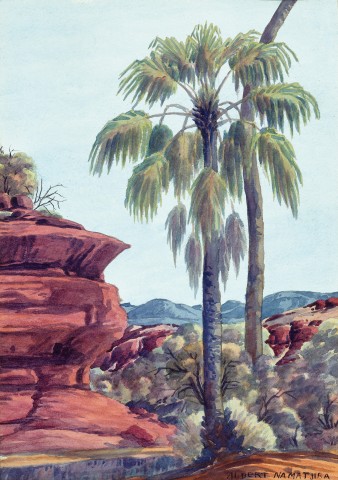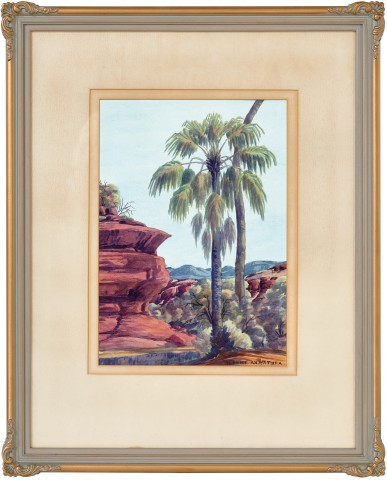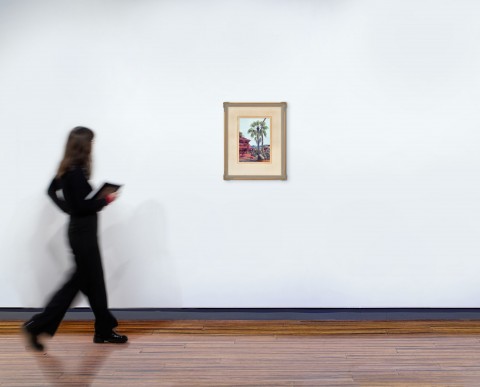PALM VALLEY, 1940s
ALBERT NAMATJIRA
watercolour on paper
40.5 x 29.5 cm (sheet)
signed lower right: ALBERT NAMATJIRA
signed and inscribed with title verso: Palm Valley / Albert Namatjira
Private collection
Henry Krongold, Melbourne
The Estate of Paul Krongold, Melbourne
Palm Valley, James Range, 1945, watercolour over pencil on paper, 57.0 x 40.0 cm, Private collection, Adelaide, illus. in French, A., Seeing the Centre: The Art of Albert Namatjira 1902 – 1959, National Gallery of Australia, Canberra, 2002, p. 111
Palm Valley, c.1936, watercolour over pencil on paper, 18.5 x 26.0 cm, in the collection of the Araluen Art Collection, Araluen Centre, Alice Springs. Gift of the late J. F. W. Schulz's grandchildren: Mrs M. Mertin, Miss E. Schulz, Mrs J. Chambers and Mrs A. Juttner. This painting was presented to Mr Schulz by Pastor Albrecht at the Hermannsburg Lutheran Mission.
From the creation of his earliest watercolours in the 1930s, Albert Namatjira provided the foundation for the later emergence of Indigenous art at Papunya forty years later and the flourishing that would follow. A household name by the 1950s, Namatjira’s evocative landscapes of inland Australia were fundamental to how Australians viewed their island home. ‘Namatjira's dramatic entry into the Australian art world was both inspired and inspiring. He inspired his own and subsequent generations of Aboriginal people and artists across Australia. In skilfully adopting the methods and materials of Western landscape painting he challenged the relegation of Aboriginal art to the realm of archaeology and ethnography. Namatjira became the most prominent Aboriginal Australian of his era and, in 1957, was the first Aboriginal person to be granted full citizenship.’1
Palm Valley, part of Namatjira's mother's country, is located in what is now known as the Finke Gorge National Park in the Northern Territory. ‘One of Namatjira’s most popular subjects particularly in the 1940s….some compositions focus on a single palm, the majority explore their relationship as a group in the intimacy of a closed environment…observed in specific light conditions.’2 In this work two central australian cabbage palms (Livistona Mariae) emerge from dense vegetation and are silhouetted against the cloudless blue sky, towering above a rocky outcrop to the left and the still rockpool below.
Known as Arrangkeye in Western Arrente language, the cabbage palm is an extremely rare plant, a remnant of a time when central Australia was much wetter and covered by such vegetation. Unique to this region, it is restricted to a small area of 60 square kilometres around the Finke River and its tributaries. During painting trips, Namatjira would return to the same site at the same hour every day in an attempt to recapture the same effect in an ever-changing environment. This work, painted in the heat of the afternoon, depicts the palm trees bathed in the strong light of mid-afternoon sun with little shade offered by the overhanging rock. The only visible relief from the heat is the cool water of the Finke tributary, shimmering at the bottom of the work.
The art of Albert Namatjira is now understood to have inspired his own and subsequent generations of Aboriginal people and artists across Australia. Namatjira’s watercolours of Palm Valley encouraged successive generations to paint there, especially Walter Ebatarinja and his wife Cordula whose idiosyncratic depictions of Palm Valley record the site from their personal perspectives. Brenda Croft argues that the artist’s gift to indigenous and non-indigenous people is ‘more than the sum parts of watercolour paints on paper. It is an essence that resides in the strength of Namatjira’s work – his courage, his sorrow, his spirituality… where the enduring influence of this one man upon the entire indigenous arts and culture industry continues to be felt.’3
1. Watson, K., ‘Poetic Justice: an overview of Indigenous Art’, in Perkins, H., One Sun, One Moon: Aboriginal Art in Australia, Art Gallery of New South Wales, Sydney, 2007, p. 20
2. French, A., Seeing the Centre: The Art of Albert Namatjira 1902-1959, National Gallery of Australia, Canberra, 2002, p.107
3. Croft, B., ‘Albert’s Gift’ in French, A., Seeing the Centre: The Art of Albert Namatjira, 1902-1959, National Gallery of Australia, Canberra, 2002, p. 148
CRISPIN GUTTERIDGE


